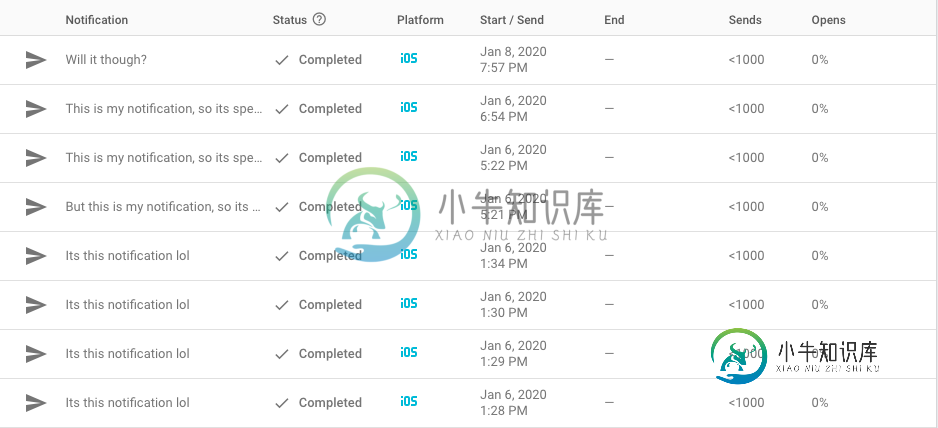iOS设备上未显示Firebase云消息通知(前台和后台)
我正在使用FCM为我的iOS应用程序创建和发送推送通知。
开发环境:
>
Xcode 11.3
-
null
问题:
在遇到问题之前,我设置了我的应用程序,使其能够在应用程序处于后台和前台时接收通知。我对自己非常高兴,我promise了代码。在此之后,我无法在前台或后台接收通知。无论使用的通知是从云消息仪表板还是邮递员发送的,我都收到一个成功的响应但通知从未出现。
起初,我认为我可能已经达到通知配额,但现在是2天后的事实。
-
null
AppDelegate.Swift
import UIKit
import Firebase
import FBSDKCoreKit
import GoogleMaps
import SwiftLocation
import GooglePlaces
import Crashlytics
import GoogleSignIn
import Armchair
import UserNotifications
import FirebaseMessaging
@UIApplicationMain
class AppDelegate: UIResponder, UIApplicationDelegate, UNUserNotificationCenterDelegate {
var window: UIWindow?
var swipeNavigationViewController: SwipeNavigationViewController!
override init() {
super.init()
FirebaseApp.configure()
Database.database().isPersistenceEnabled = true
swipeNavigationViewController = SwipeNavigationViewController()
}
func application(_ application: UIApplication, didFinishLaunchingWithOptions launchOptions: [UIApplication.LaunchOptionsKey : Any]? = nil) -> Bool {
FirebaseConfiguration.shared.setLoggerLevel(.error)
ApplicationDelegate.shared.application(application, didFinishLaunchingWithOptions: launchOptions)
// Google Maps
GMSServices.provideAPIKey(FireBaseConstants.GoogleAPIKey)
GMSPlacesClient.provideAPIKey(FireBaseConstants.GoogleAPIKey)
GeocoderRequest.GoogleOptions(APIKey: FireBaseConstants.GoogleAPIKey)
let navigationViewController = UINavigationController(rootViewController: swipeNavigationViewController)
navigationViewController.setNavigationBarHidden(true, animated: false)
self.window?.rootViewController = navigationViewController
self.window?.makeKeyAndVisible()
showAlertIfPointedTowardProductionDatabase()
setupReviewRequest()
UIApplication.shared.registerForRemoteNotifications()
let center = UNUserNotificationCenter.current()
center.requestAuthorization(options:[.badge, .alert, .sound]) { (granted, error) in
// If granted comes true you can enabled features based on authorization.
guard granted else { return }
DispatchQueue.main.async {
print("UserID: \(UserManager.sharedManager.currentUser?.userID)")
let pushManager = PushNotificationManager(userID: "currently_logged_in_user_id")
pushManager.registerForPushNotifications()
}
}
UNUserNotificationCenter.current().delegate = self
return true
}
func application(_ app: UIApplication, open url: URL, options: [UIApplication.OpenURLOptionsKey : Any] = [:]) -> Bool {
let handledByFB = ApplicationDelegate.shared.application(app, open: url, options: options)
var handledByGoogle = false
if !handledByFB {
handledByGoogle = GIDSignIn.sharedInstance().handle(url)
}
let handled = handledByFB || handledByGoogle
return handled
}
private func setupReviewRequest() {
//Code...
}
// This method will be called when app received push notifications in foreground
func userNotificationCenter(_ center: UNUserNotificationCenter, willPresent notification: UNNotification, withCompletionHandler completionHandler: @escaping (UNNotificationPresentationOptions) -> Void) {
completionHandler([.alert, .badge, .sound])
}
}
PushNotificationManager.Swift
import Foundation
import Firebase
import FirebaseFirestore
import FirebaseMessaging
import UIKit
import UserNotifications
class PushNotificationManager: NSObject, MessagingDelegate, UNUserNotificationCenterDelegate {
let userID: String
let gcmMessageIDKey = "gcm.message_id"
init(userID: String) {
self.userID = userID
super.init()
}
func registerForPushNotifications() {
let authOptions: UNAuthorizationOptions = [.alert, .badge, .sound]
UNUserNotificationCenter.current().requestAuthorization(options: authOptions) { (_, error) in
guard error == nil else{
print(error!.localizedDescription)
return
}
}
//get application instance ID
InstanceID.instanceID().instanceID { (result, error) in
if let error = error {
print("Error fetching remote instance ID: \(error)")
} else if let result = result {
print("Remote instance ID token: \(result.token)")
}
}
UIApplication.shared.registerForRemoteNotifications()
updateFirestorePushTokenIfNeeded()
}
func updateFirestorePushTokenIfNeeded() {
if let token = Messaging.messaging().fcmToken {
// let usersRef = Firestore.firestore().collection("users_table").document(userID)
// usersRef.setData(["fcmToken": token], merge: true)
print("Remote instance ID token: \(token)")
}
}
func messaging(_ messaging: Messaging, didReceiveRegistrationToken fcmToken: String) {
print("Firebase registration token: \(fcmToken)")
let dataDict:[String: String] = ["token": fcmToken]
NotificationCenter.default.post(name: Notification.Name("FCMToken"), object: nil, userInfo: dataDict)
// TODO: If necessary send token to application server.
// Note: This callback is fired at each app startup and whenever a new token is generated.
}
func messaging(_ messaging: Messaging, didReceive remoteMessage: MessagingRemoteMessage) {
print("Received data message: \(remoteMessage.appData)")
}
func userNotificationCenter(_ center: UNUserNotificationCenter, didReceive response: UNNotificationResponse, withCompletionHandler completionHandler: @escaping () -> Void) {
print(response)
}
func application(_ application: UIApplication, didReceiveRemoteNotification userInfo: [AnyHashable: Any]) {
if let messageID = userInfo[gcmMessageIDKey] {
print("Message ID: \(messageID)")
}
print(userInfo)
}
func application(_ application: UIApplication, didFailToRegisterForRemoteNotificationsWithError error: Error) {
print("Unable to register for remote notifications: \(error.localizedDescription)")
}
func application(_ application: UIApplication,didRegisterForRemoteNotificationsWithDeviceToken deviceToken: Data) {
let tokenParts = deviceToken.map { //data -> String in
return String(format: "%02.2hhx", $0)
}
Messaging.messaging().apnsToken = deviceToken
Messaging.messaging().setAPNSToken(deviceToken, type: .unknown)
UserDefaults.standard.synchronize()
}
}
这是使用以下所有链接设置的(我肯定还有一些其他链接我也忘了):
-
null
{
"multicast_id": 2586780331808083728,
"success": 1,
"failure": 0,
"canonical_ids": 0,
"results": [
{
"message_id": "0:1578532253832479%2b1845e62b1845e6"
}
]
}
云消息传递:

共有1个答案
我通过搬家来解决这个问题
func application(_ application: UIApplication, didRegisterForRemoteNotificationsWithDeviceToken deviceToken: Data)
从PushNotificationManager到AppDelegate。希望这能帮助别人!
-
使用更新的Firebase cloud messaging和swizzling方法,当我的应用程序前景化时,我能够成功地在我的应用程序委托中的方法中接收有效负载。但是,我没有收到任何类型的有效负载,并且当我的应用程序处于后台时,不会被调用,尽管api响应消息已成功发送(见下文) 以下是我发送给FCM api的请求,以触发推送通知 有FCM的回复 这是我的appDelegate代码 我在我的应用程序
-
我正在接收令牌,但当我从Firebase控制台发送通知时,我的设备上不会发生任何事情,无论应用是否处于后地。与此同时,我的Android应用程序收到通知。 我遵循了这个指南: https://firebase.google.com/docs/cloud-messaging/ios/client 为了确保这一点,我还在 https://github.com/firebase/quickstart-i
-
我对FireBase云消息有一个问题,我从设备中获取令牌,并通过Google FireBase通知控制台发送通知测试。但是,通知从来没有被记录,也没有被推送到android虚拟设备。FCM的文档几乎与下面的代码完全相同,其他代码很少,您还需要做什么来获得使用FireBase的推送通知。我已经完成了所有的设置信息(build.gradle添加、安装google play服务等)如文档中所指定的,但仍
-
我正在尝试使用Firebase Notification Composer向我的设备发送测试通知。我正在接收FCM令牌并将其打印到我的控制台,然后尝试向该令牌发送通知。 以下是我检查过的内容: 1) 我使用的是iOS 12.4.1 2) 我正在分配消息传递代理 3)我从委托方法接收FCM令牌 4) 我已经验证了通知是通过打印到控制台启用的,当提示我允许通知时,我单击了允许 5) 我已经验证了在Fi
-
我在项目中使用Firebase身份验证。今天我决定将FCM集成到我的项目中。但是我无法从我的Firebase控制台收到任何通知。我还尝试重新下载. json文件,但没有成功。你们知道我的问题吗? Android清单.xml FirebaseMessageService.java FirebaseIDService.java 我认为这个问题不是由我的MainActiviy.java决定的,但以防万一
-
我在Android中有一个应用程序,它接收来自firebase的通知,但当它在前台时,新的通知会取代以前的通知。我怎样才能全部展示出来?这是我的课。 公共类FirebaseNotifications扩展了FirebaseMessagingService{private static final String TAG=“MyFirebaseMsgService”; }

